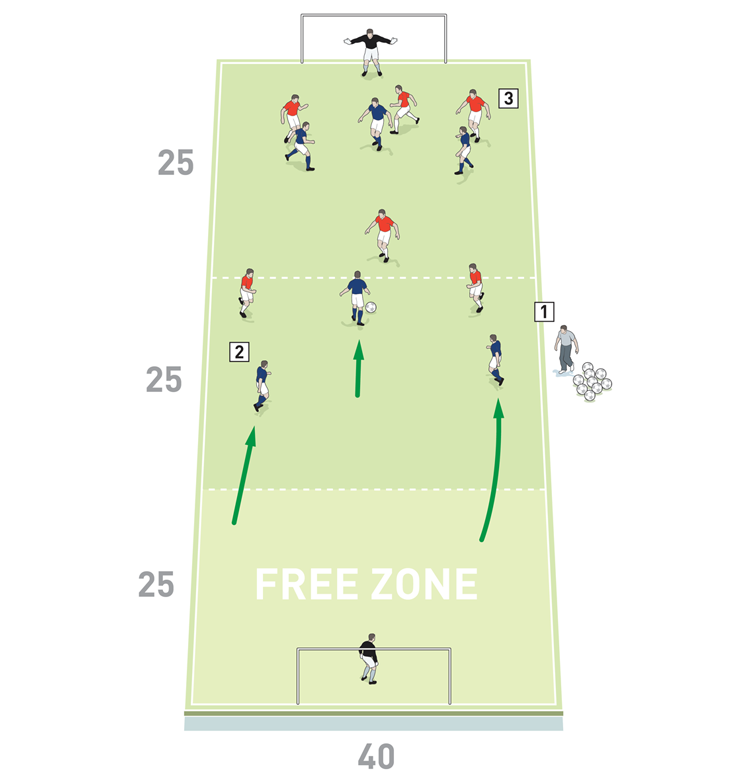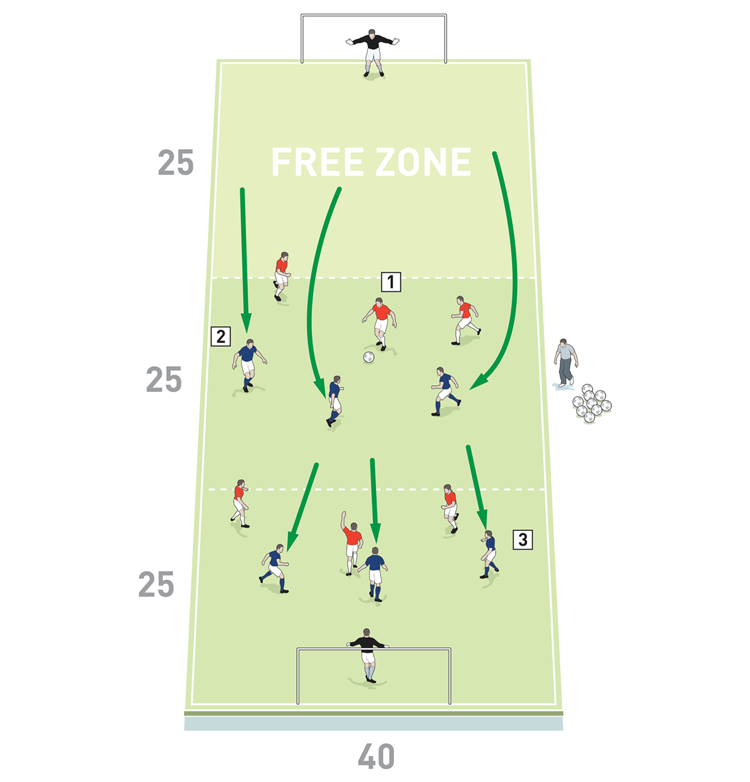




OUR BEST EVER OFFER - SAVE £100/$100
JOIN THE WORLD'S LEADING PROFESSIONAL DEVELOPMENT PROGRAMME
- 12 months membership of Elite Soccer
- Print copy of Elite Player & Coach Development
- Print copy of The Training Ground
Compact team movement
This session is about movement of the team in attack and defence to ensure we remain compact with good distances between players. It also helps us develop good spatial awareness of the player in and out of possession, as well as creating good options for the man on the ball.
| Area | Up to a full pitch |
| Equipment | Balls, cones, goals |
| No. of Players | Up to 11v11 |
| Session Time |
Zones practice, 6x4mins with 2mins, recovery (34mins total) |
This session is about movement of the team in attack and defence to ensure we remain compact with good distances between players. It also helps us develop good spatial awareness of the player in and out of possession, as well as creating good options for the man on the ball.
Although this is simple in its set-up, it houses key principles of organisation, and its effect shouldn’t be underestimated. Done well it’s easy to recreate match intensity whilst improving the synchronisation of the movement of certain partnerships and their communication.
If the fixture schedule allows we will run this once a week, otherwise we’ll ensure it’s played out fortnightly so as to ensure players maintain good habits in the way we try to play. It’s important to find other exercises which would promote the movement of the team in compact spaces with a variation on this exercise.
What do I get the players to do?
Warm-up (not shown)
We will begin with a warm-up and activation exercises, which can be dictated by the coaches taking the session.
Zones practice
We set up using a pitch divided into three zones of 25x40 yards, with a full-size goal at each end, as shown (1a). It’s 6v6 and teams can only use two zones.
The coach will start and restart the play from the middle of the pitch, therefore immediately forcing players to think and move as a team.
As shown, blues attack the top goal with all six players needing to be positioned in the two upper 25-yard zones. We can also run this without keepers with 10 consecutive passes needing to be made in two zones.
1a

2. Play is worked forward with blues moving from the defensive to the middle zone
3. Reds must retreat, ensuring that all players are positioned defensively and none are in the free zone
If a team loses possession in the attacking final zone there is a condition that they always have to retreat into the deepest two 25-yard zones (1b). The same instructions apply for opponents, so both teams will play using one free end zone. Outside of these conditions normal football rules apply.
1b

2. Upon turnover it’s now the blues who must quickly vacate the attacking zone
3. Three blues occupy each zone with a balanced approach to defending
How do I progress the practice?
The session can be progressed with pitch size and/or player numbers being increased as well as allowing players to make more informed decisions upon turnovers. So, after losing possession do they press the ball high up or drop off? This decision-making can only come from assessing conditions around them, and that can only come from practice.
We can also change things by enabling the restart from keepers, which presents an immediate pressing opportunity for the opposition. In addition, limiting players to two touches can vary the effectiveness of what we are looking for, both positively (quick play and fast moves) and negatively (rushed decision-making), but is again a key component in recreating and practising the realities of match situations.
A common mistake made is when teams do not ensure a free zone is maintained when both in and out of possession. To avoid this, we would penalise the team that’s infringing – for instance if a player from the defending team is in the ‘free’ zone with opponents attacking, any goal for attackers would be counted as two.
What are the key things to look out for?
In terms of the key technical aspects, we’re looking for quick ball movement in possession in the final zone in order to create plentiful goalscoring situations. Within this, and from a technical attacking point of view, we need to ensure that as the ball travels so players travel as well, getting into the correct zones especially when the ball is in the attacking third.
Defensively, players need to be organised in the way they retreat, preferably with an even split of men in the two zones they are occupying.
How do I put this into a game situation?
For a game situation we will extend this onto a full pitch utilising what are, effectively, four zones, with teams only able to use two at any given time (2). The halfway lines divides the middle zone into two, forcing the compactness of the team during the game. Different conditions in the way we show the teams to use the zones will give the exercise specialised meaning to work an specific topic for the team. Both teams are placed in tactical shape – for instance 1-4-3-3 against 1-4-1-4-1 – with a premise of limiting the number of touches for players in different areas of the pitch.
2

1. The ball begins from the keeper
2. It’s worked out to a blue
3. Reds must now vacate the attacking zone
4. Other reds track back to occupy the two defensive zones only
Related Files
Editor's Picks
Attacking transitions
Deep runs in the final third
Using the goalkeeper in build-up play
Intensive boxes drill with goals
Penetrating the final third
Creating and finishing
My philosophy
Pressing initiation
Compact team movement
Coaches' Testimonials

Alan Pardew

Arsène Wenger

Brendan Rodgers

Carlos Carvalhal

José Mourinho

Jürgen Klopp

Pep Guardiola

Roy Hodgson

Sir Alex Ferguson

Steven Gerrard
Coaches' Testimonials

Gerald Kearney, Downtown Las Vegas Soccer Club

Paul Butler, Florida, USA

Rick Shields, Springboro, USA

Tony Green, Pierrefonds Titans, Quebec, Canada
Join the world's leading coaches and managers and discover for yourself one of the best kept secrets in coaching. No other training tool on the planet is written or read by the calibre of names you’ll find in Elite Soccer.
In a recent survey 92% of subscribers said Elite Soccer makes them more confident, 89% said it makes them a more effective coach and 91% said it makes them more inspired.
Get Monthly Inspiration
All the latest techniques and approaches
Since 2010 Elite Soccer has given subscribers exclusive insight into the training ground practices of the world’s best coaches. Published in partnership with the League Managers Association we have unparalleled access to the leading lights in the English leagues, as well as a host of international managers.
Elite Soccer exclusively features sessions written by the coaches themselves. There are no observed sessions and no sessions “in the style of”, just first-hand advice delivered direct to you from the coach.







